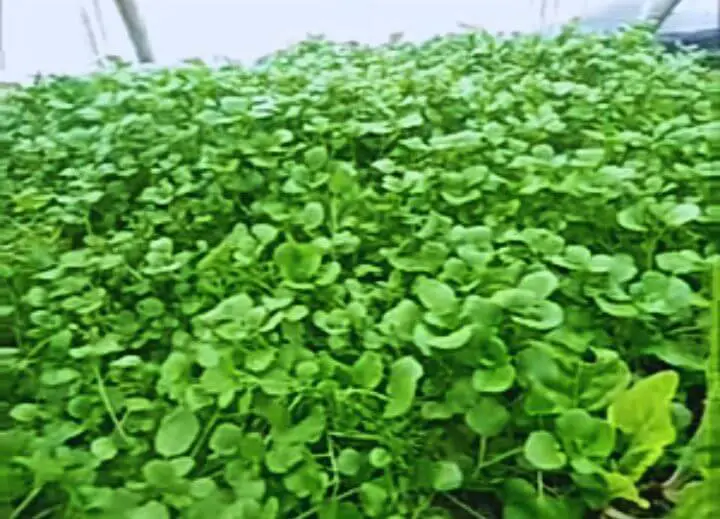
Watercress is a green leafy vegetable herb that belongs to the Brassicaceae family of vegetables. This vegetable herb is mostly loved because of its smooth peppery flavor. Apart from its peppery flavor research has confirmed that watercress contains many vitamins like Vitamin C, Vitamin D, and Vitamin B6. It also contains some important minerals such as Iron, Magnesium, and Calcium. Here are the steps on how to grow and care for watercress plant. Here are some tips for growing watercress plant.
Growing, Planting and Caring watercress plant
Watercress grows best in cool, running water with temperatures between 50-70°F. It likes shallow, oxygen-rich water. The ideal planting location is a stream, creek, or spring with moving water and a slightly alkaline pH. Watercress does not do well in stagnant water. The ideal water temperature is between 50-68°F. Much warmer and the plants will bolt and become bitter.
Prepare a planting bed by removing any debris and loosening the soil or sand at the bottom of the stream or creek bed. Make small furrows about 4-6 inches apart. Plant watercress cuttings, taking 3-4 inch stem cuttings from existing plants. Push the cuttings into the furrows, spacing them about 6 inches apart. Transplant watercress seedlings or cuttings into a stream bed, spring, or other shallow-flowing water source.
Cover the cuttings with a thin layer of soil or sand and use rocks to weigh them down and keep them in place. Water frequently to keep the planting bed consistently moist until the watercress is established.
Harvesting Watercress
Once growing, watercress plant can spread quickly. Harvest by cutting entire stems off at the base, taking only what you need. Fertilize sparingly if growth slows. Too much fertilizer will cause excessive stem elongation. Rotate beds occasionally to rejuvenate the growing area and reduce disease. Providing the right cool, flowing water conditions is key for successfully cultivating watercress. With the proper environment, it can grow vigorously.
Watercress Health Benefits
1. Antioxidants
Watercress is an excellent source of antioxidants like vitamin C, vitamin E, lutein, and zeaxanthin, which help protect cells from damage by free radicals.
2. Cancer Prevention
Studies suggest that compounds in watercress, such as isothiocyanates and phenolic compounds, may have anti-cancer properties, potentially reducing the risk of cancers like breast, lung, and prostate cancer.
3. Heart Health
Watercress is a good source of folate and dietary nitrates, which can help regulate blood pressure and improve blood flow, reducing the risk of heart disease.
4. Bone Health
Watercress is high in vitamin K, which is essential for bone health and helps prevent osteoporosis.
5. Skin Health
The vitamins A, C, and E in watercress may help protect skin from UV damage and promote skin elasticity and healing.
6. Immune System Support
Watercress contains vitamin C, vitamin E, and other antioxidants that help strengthen the immune system.
7. Detoxification
Compounds like isothiocyanates and glucosinolates in watercress may aid in the detoxification process by activating enzymes that help eliminate toxins and carcinogens from the body.
8. Low in Calories
Watercress is a low-calorie food, making it an excellent addition to a weight management diet.
Companion Plants For Watercress
1. Mint
Mint thrives in moist soil and can help deter pests like flea beetles that may attack watercress. Peppermint and spearmint make good companions.
2. Chives
Chives can help repel aphids and other pests. They also grow well in damp soil near bodies of water.
3. Horseradish
Horseradish has similar growing requirements to watercress, preferring cool, damp conditions. It can also act as a natural pest deterrent.
4. Nasturtiums
The peppery flavor of nasturtiums complements the watercress well. They also have pest-repelling properties.
5. Parsley
Parsley can thrive in moist soil and provides some shade for watercress during hot weather. It also attracts beneficial insects.
6. Dill
Dill likes moisture and can help attract predatory insects that prey on pests that may bother watercress.
7. Marigolds
Marigolds release compounds that can deter nematodes and other soil-borne pests, benefiting nearby watercress.
8. Chamomile
Chamomile is a good ground cover for watercress beds and can improve the overall soil quality.
Frequently Asked Questions
1. What is watercress good for?
Watercress contains minerals like calcium and potassium. Calcium helps to strengthen bones and teeth while potassium helps your body regulate your heartbeat salt levels and blood pressure. It also contains important vitamins such as vitamin A and Vitamin B6 which are essential for body development and immunity.
2. What is another name for a watercress?
Watercress is also called yellowcress and its botanical name is Nasturtium officinale.
3. Can I eat watercress raw?
Yes, watercress can be eaten raw. It can be chewed when fresh.
4. Does watercress cleanse your body?
Yes, research has confirmed that watercress have natural diuretic properties which can help to flush toxins out of the body.
5. Is watercress good for kidneys?
Watercress is suitable except for people with kidney stones, this is because watercress contains oxalate compounds that can lead to more kidney stones.
6. Is watercress a fruit or vegetable?
Watercress is a type of vegetable classified in the same family as kale, cabbage, and Brussels sprout.
7. Is watercress like spinach?
Watercress is just a vegetable like kale and spinach, so it’s appropriate when used as a substitute for spinach.
Also Read:-
How To Grow Broccoli Sprouts-Requirements And Procedure
CREEPING CHARLIE LOOK ALIKES-Seven plants that look like Creeping Charlie
